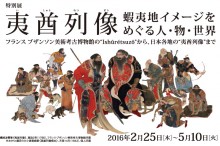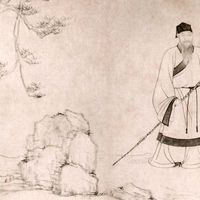Exhibition: "Ishuretsuzo, the Image of Ezo" | Japan

 The National Museum of Ethnology in Osaka, Japan, an ASEMUS member, hosts the exhibition "Ishuretsuzo, the Image of Ezo: Tracing Persons, Things and the World" between 25 February and 10 May 2016.
"Ishuretsuzo", a series of twelve portraits of leading Ainu figures clothed in vivid, elaborately-decorated traditional fabric, was painted in 1790 by samurai and artist Hakyo Kakizaki of the Matsumae domain. The series was praised by the Emperor and feudal lords of the time and was subsequently hand-copied many times.
Hakyo Kakizaki created the images using a variety of elements particular to contemporary pictorial art, such as the style of Chinese painter Shin Nanpin (the founder of the Nanpin school) ‒ a popular technique that Hakyo learned in Edo; the expressive style of Western paintings, which had just been introduced to Japan; the postures of hermits depicted in illustrated catalogs, which were much talked about; and the formats used in portraits of meritorious Chinese retainers. The exhibition highlights these elements through the works of notable painters of the time, including the monk Gessen and Shiseki So, under whom Hakyo studied.
Behind the Ishuretsuzo collection was a network of people with surprising interconnections. These included the aforementioned painters, Emperor Kokaku (who actually saw the Ishuretsuzo collection) and other nobles, writers such as Kien Minagawa and Zenji Daiten, powerful feudal lords (known as daimyo) such as Seizan Matsura and Sadanobu Matsudaira (who ordered the reproduction of the Ishuretsuzo collection), and the daimyo painters who actually reproduced the works. The exhibition traces such connections to the Ishuretsuzo collection through paintings.
This exhibition brings together the original Ishuretsuzo works by Hakyo Kakizaki housed at the Besançon Museum of Fine Arts and Archaeology in France, as well as reproductions and related works from around Japan. Highlighting the interactions of people, exchanges of materials, and influences of the "outside world" that began to grow in Japan, this exhibition explores images from 18th-century "Ezochi" to the present "Hokkaido".
The Ishuretsuzo exhibition results from a collaboration between the National Museum of Ethnology, the National Museum of Japanese History and the Hokkaido Museum, in partnership with the Besançon Museum of Fine Arts and Archaeology, the town of Matsumae and the Senri Foundation.
A catalogue of the exhibition is available, and a set of related activities have been planned.
For additional information, please visit http://www.minpaku.ac.jp/english/museum/exhibition/special/20160225ishu/index
The National Museum of Ethnology in Osaka, Japan, an ASEMUS member, hosts the exhibition "Ishuretsuzo, the Image of Ezo: Tracing Persons, Things and the World" between 25 February and 10 May 2016.
"Ishuretsuzo", a series of twelve portraits of leading Ainu figures clothed in vivid, elaborately-decorated traditional fabric, was painted in 1790 by samurai and artist Hakyo Kakizaki of the Matsumae domain. The series was praised by the Emperor and feudal lords of the time and was subsequently hand-copied many times.
Hakyo Kakizaki created the images using a variety of elements particular to contemporary pictorial art, such as the style of Chinese painter Shin Nanpin (the founder of the Nanpin school) ‒ a popular technique that Hakyo learned in Edo; the expressive style of Western paintings, which had just been introduced to Japan; the postures of hermits depicted in illustrated catalogs, which were much talked about; and the formats used in portraits of meritorious Chinese retainers. The exhibition highlights these elements through the works of notable painters of the time, including the monk Gessen and Shiseki So, under whom Hakyo studied.
Behind the Ishuretsuzo collection was a network of people with surprising interconnections. These included the aforementioned painters, Emperor Kokaku (who actually saw the Ishuretsuzo collection) and other nobles, writers such as Kien Minagawa and Zenji Daiten, powerful feudal lords (known as daimyo) such as Seizan Matsura and Sadanobu Matsudaira (who ordered the reproduction of the Ishuretsuzo collection), and the daimyo painters who actually reproduced the works. The exhibition traces such connections to the Ishuretsuzo collection through paintings.
This exhibition brings together the original Ishuretsuzo works by Hakyo Kakizaki housed at the Besançon Museum of Fine Arts and Archaeology in France, as well as reproductions and related works from around Japan. Highlighting the interactions of people, exchanges of materials, and influences of the "outside world" that began to grow in Japan, this exhibition explores images from 18th-century "Ezochi" to the present "Hokkaido".
The Ishuretsuzo exhibition results from a collaboration between the National Museum of Ethnology, the National Museum of Japanese History and the Hokkaido Museum, in partnership with the Besançon Museum of Fine Arts and Archaeology, the town of Matsumae and the Senri Foundation.
A catalogue of the exhibition is available, and a set of related activities have been planned.
For additional information, please visit http://www.minpaku.ac.jp/english/museum/exhibition/special/20160225ishu/index
Pictured above: exhibition poster and Ishuretsuzo painting by Hakyo Kakizaki, Besançon Museum of Fine Arts and Archaeology
Similar content
from - to
02 Jan 2012 - 19 Feb 2012
from - to
02 Jan 2012 - 19 Feb 2012
16 Nov 2017 - 11 Mar 2018
from - to
06 Apr 2012 - 15 Jul 2012
from - to
28 Jul 2012 - 10 Mar 2013
from - to
31 Aug 2013 - 23 Mar 2014

